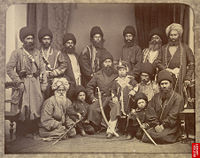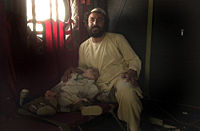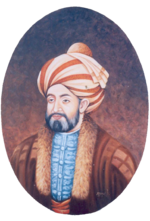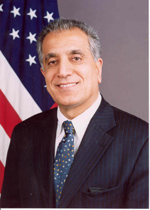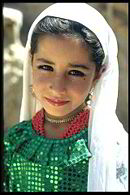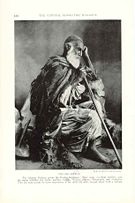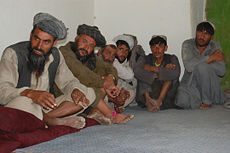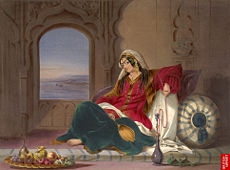Pashtun people
2008/9 Schools Wikipedia Selection. Related subjects: Peoples
| Pashtuns پښتون Paṣtun |
||||||||||||||||||||||||
|---|---|---|---|---|---|---|---|---|---|---|---|---|---|---|---|---|---|---|---|---|---|---|---|---|
    |
||||||||||||||||||||||||
| Sher Shah Suri · Sher Ali Khan · Abdur Rahman Khan Mohammed Nadir Khan |
||||||||||||||||||||||||
| Total population | ||||||||||||||||||||||||
|
ca. 42 million |
||||||||||||||||||||||||
| Regions with significant populations | ||||||||||||||||||||||||
|
||||||||||||||||||||||||
| Languages | ||||||||||||||||||||||||
| Pashto Persian or Urdu also spoken widely as second languages |
||||||||||||||||||||||||
| Religion | ||||||||||||||||||||||||
| Islam, predominantly Hanafi Sunni with a Twelver Shia minority |
Pashtuns ( Pashto: پښتون Paṣtūn or پختون Paxtūn, also rendered as Pushtuns, Pakhtuns, Pukhtuns), also called Pathans (Urdu: پٹھان, Hindi: पठान Paṭhān), ethnic Afghans, or synonymously Afghans ( Persian: افغان Afğān), are an Eastern Iranian ethno-linguistic group with populations primarily in eastern and southern Afghanistan and in the North-West Frontier Province, Federally Administered Tribal Areas and Balochistan provinces of western Pakistan. The Pashtuns are typically characterized by their usage of the Pashto language and practice of Pashtunwali, which is a traditional code of conduct and honour.
Pashtun society consists of many tribes and clans which were rarely politically united, until the rise of the Durrani Empire in 1747. Pashtuns played a vital role during the Great Game as they were caught between the imperialist designs of the British and Russian empires. For over 250 years, they reigned as the dominant ethnic group in Afghanistan. They gained world-wide attention after the Soviet invasion of Afghanistan in 1979 and with the rise and fall of the Taliban, since they were the main ethnic contingent in the movement. Pashtuns are also an important community in Pakistan, where they are prominently represented in the military and are the second-largest ethnic group.
The Pashtuns are the world's largest (patriarchal) segmentary lineage ethnic group. The total population of the group is estimated to be around 42 million, but an accurate count remains elusive due to the lack of an official census in Afghanistan since 1979. There are an estimated 60 major Pashtun tribes and more than 400 sub-clans.
Demographics
The vast majority of Pashtuns are found in an area stretching from southeastern Afghanistan to northwestern Pakistan. Additional Pashtun communities are found in the Northern Areas of Pakistan and in Khorasan Province of eastern Iran. There is also a sizeable community in India, that is of largely putative ancestry. A large migrant-worker community resides in the countries of the Arabian Peninsula and in smaller communities in Europe and North America. Important metropolitan centers of Pashtun culture include Peshawar and Kandahar. Quetta and Kabul are ethnically mixed cities with large Pashtun populations. With 1.5 million ethnic Pashtuns, Karachi hosts one of the largest Pashtun populations in the world.
Pashtuns comprise over 15.42% of Pakistan's population or 25.6 million people. In Afghanistan, they make up an estimated 39% to 42% of the population or 12.4 to 13.3 million people. The exact numbers remain uncertain, particularly in Afghanistan, and are affected by approximately 3 million Afghan refugees that remain in Pakistan, of which 81.5% or 2.49 million are ethnic Pashtuns. An unknown number of refugees continue to reside in Iran. A cumulative population assessment suggests a total of around 42 million across the region.
History and origins
The history of the Pashtuns is ancient, and much of it is not fully researched. Since the 2nd millennium BC, regions now inhabited by Pashtuns have seen invasions and migrations, including by Aryan tribes (Iranian peoples, Indo-Aryans), Medes, Persians, Mauryas, Scythians, Kushans, Hephthalites, Greeks, Arabs, Turks, and Mongols. There are many conflicting theories about the origins of the Pashtun people, some modern and others archaic, both among historians and the Pashtuns themselves.
Anthropology and linguistics
The origins of the Pashtuns are eastern Iranian. The Pashto language is classified under the Eastern Iranian sub-branch of the Iranian branch of the Indo-European family of languages. Thus, Pashtuns are classified as an Iranian people, possibly as partial descendants of the Scythians, an ancient Iranian group.
Early precursors to the Pashtuns were Old Iranian tribes that spread throughout the eastern Iranian plateau. According to academic Yu. V. Gankovsky, the Pashtuns began as a "union of largely East-Iranian tribes which became the initial ethnic stratum of the Pashtun ethnogenesis, dates from the middle of the first millennium CE and is connected with the dissolution of the Epthalite (White Huns) confederacy."
Pashtuns who speak a southern dialect of Pashto refer to themselves as Pashtuns, while those who speak a northern dialect as Pukhtuns. These Pashtuns compose the core of ethnic Pashtuns who are found in western Pakistan and southern-eastern Afghanistan. Like other Iranian peoples, many Pashtuns have mixed with various invaders, neighboring groups, and migrants. In terms of phenotype, Pashtuns are predominantly a Mediterranean people, so light hair, eye colors and pale skin are not uncommon, especially among remote mountain tribes.
Oral traditions
Some anthropologists lend credence to the mythical oral traditions of the Pashtun tribes themselves. For example, according to the Encyclopaedia of Islam, the theory of Pashtun descent from Israelites is traced to Maghzan-e-Afghani who compiled a history for Khan-e-Jehan Lodhi in the reign of Mughal Emperor Jehangir in the 17th century.
Another book that corresponds with Pashtun historical records, Taaqati-Nasiri, states that in the 7th century a people called the Bani Israel settled in Ghor, southeast of Herat, Afghanistan, and then migrated south and east. These references to Bani Israel agree with the commonly held view by Pashtuns that when the twelve tribes of Israel were dispersed (see Israel and Judah and Ten Lost Tribes), the tribe of Joseph, among other Hebrew tribes, settled in the region. This oral tradition is widespread among the Pashtuns. There have been many legends over the centuries of descent from the Ten Lost Tribes after groups converted to Christianity and Islam. Hence the tribal name ' Yusef Zai' in Pashto translates to the 'sons of Joseph'. A similar story is told by Iranian historian Ferishta.
But the Bani-Israel theory has major historical and linguistic inconsistencies. The main one is that the Ten Lost Tribes were exiled by Assyria, while Maghzan-e-Afghani says they were permitted by the ruler of Persia to go east to Afghanistan. This inconsistency can be explained by the fact that Persia acquired the lands of the ancient Assyrian Empire when it conquered the Empire of the Medes and Chaldean Babylonia, which had conquered Assyria decades earlier. But no ancient author mentions such a transfer of Israelites further east, or no ancient extra-Biblical texts refer to the Ten Lost Tribes at all. Also, the Rig Veda, believed to have been composed before 1200 BC, already mentions the Pashtuns as living in the area of Afghanistan. No ancient author before the conversion of the Pashtuns to Islam mentions any Israelite or Jewish connection. The oral tradition may be a myth which grew out of a political and cultural struggle with the Mughals.
Other Pashtun tribes claim descent from Arabs, including some even claiming to be descendants of the Muslim Prophet Muhammad (popularly referred to as sayyids). Some groups from Peshawar and Kandahar (such as the Afridis , Khattaks and Sadozais) also claim to be descended from Alexander the Great's Greeks.
Genetics
Research into human DNA is as a new way to explore historical movements of populations by studying their genetic make-up. Some recent genetic genealogy studies show Pashto-speaking Pashtuns are mainly related to Iranian peoples and to the Burusho who speak a language isolate. There is evidence of a small Greek contribution to the Pashtun gene pool that will likely require further testing in order to ascertain its pervasiveness.
Modern era
The Pashtuns are intimately tied to the history of modern Afghanistan and western Pakistan. Following Muslim Arab and Turkic conquests from the 7th to 11th centuries, Pashtun ghazis (warriors for the faith) invaded and conquered much of northern India during the Khilji dynasty (1290-1321), Lodhi dynasty (1451-1526) and Suri dynasty (1540-1556). The Pashtuns' modern past stretches back to the Hotaki dynasty (1709-1738) and later the Durrani Empire (1747-1823). The Hotakis were Ghilzai tribesmen, who defeated the Safavid dynasty of Persia and seized control over much of the Persian Empire from 1722 to 1738. This was followed by the conquests of Ahmad Shah Durrani who was a former high-ranking military commander under the ruler Nadir Shah of Persia. He founded the Durrani Empire that covered most of what is today Afghanistan, Pakistan, Kashmir, Indian Punjab, and Khorasan province of Iran. After the fall of the Durrani Empire in 1818, the Barakzai clan took control of Afghanistan. Specifically, the Mohamedzai subclan ruled Afghanistan from 1826 to the end of Mohammad Zahir Shah reign in 1973. This legacy continues into modern times as Afghanistan is run by President Hamid Karzai, who is an ethnic Pashtun from Kandahar.
The Pashtuns in Afghanistan resisted British designs upon their territory and kept the Russians at bay during the so-called Great Game. By playing the two empires against each other, Afghanistan remained an independent state and maintained some autonomy (see the Siege of Malakand). But during the reign of Abdur Rahman Khan (1880-1901), Pashtun regions were divided by the Durand Line, and what is today western Pakistan was ceded to British India in 1893. In the 20th century, some Pashtun leaders living under British Indian rule in the North-West Frontier Province supported Indian independence, including Khan Wali Khan and Khan Abdul Ghaffar Khan (both members of the Khudai Khidmatgar, popularly referred to as the Surkh posh or "the Red shirts"), and were inspired by Mahatma Gandhi's non-violent method of resistance. Later, in the 1970s, Khan Wali Khan pressed for more autonomy for Pashtuns in Pakistan.
Pashtuns in Afghanistan attained complete independence from British intervention during the reign of King Amanullah Khan, following the Third Anglo-Afghan War. The monarchy ended when Sardar Daoud Khan seized control of Afghanistan in 1973. This opened the door to Soviet intervention and culminated in the Communist Saur Revolution in 1978. Starting in the late 1970s, many Pashtuns joined the Mujahideen opposition against the Soviet invasion of Afghanistan. They fought for control of Afghanistan against the Communist Khalq and the Parcham factions. More recently, the Pashtuns became known for being the primary ethnic group that comprised the Taliban, which was a religious movement that emerged from Kandahar, Afghanistan. In late 2001, the Taliban government was removed from power as a result of the US-led invasion of Afghanistan.
Pashtuns have played an important role in the regions of South and Central Asia and the Middle East. In neighboring Pakistan, ethnic Pashtun politicians, notably Ayub Khan and Ghulam Ishaq Khan, have also attained the Presidency, as well as high government posts such as Army Chief (Gul Hasan Khan) and Ministries. The Afghan royal family, now represented by Muhammad Zahir Shah, is also of ethnic Pashtun origin. Other prominent Pashtuns include the 17th-century warrior poet Khushal Khan Khattak, Afghan "Iron" Emir Abdur Rahman Khan, and in modern times U.S. Ambassador to the United Nations Zalmay Khalilzad and former Afghan Astronaut Abdul Ahad Mohmand among many others.
Pashtuns defined
Among historians, anthropologists, and the Pashtuns themselves, there is some debate as to who exactly is a Pashtun. The most prominent views are:
- Pashtuns are predominantly an Eastern Iranian people who are speakers of the Pashto language and live in a contiguous geographic location across Pakistan and Afghanistan. This is the generally accepted academic view.
- Pashtuns are Muslims who follow Pashtunwali, speak Pashto and meet other criteria.
- In accordance with the legend of Qais Abdur Rashid, the figure traditionally regarded as progenitor of the Pashtun people, Pashtuns are those whose related patrilineal descent may be traced back to legendary times.
These three definitions may be described as the ethno-linguistic definition, the religious-cultural definition, and the patrilineal definition, respectively.
Ethnic definition
The ethno-linguistic definition is the most prominent and accepted view as to who is and is not a Pashtun. Generally, this most common view holds that Pashtuns are defined within the parameters of having mainly eastern Iranian ethnic origins, sharing a common language, culture and history, living in relatively close geographic proximity to each other, and acknowledging each other as kinsmen. Thus, tribes that speak disparate yet mutually intelligible dialects of Pashto acknowledge each other as ethnic Pashtuns and even subscribe to certain dialects as "proper", such as the Pukhtu spoken by the Yousafzai and the Pashto spoken by the Durrani in Kandahar. These criteria tend to be used by most Pashtuns in Pakistan and Afghanistan.
Cultural definition
The religious and cultural definition is more stringent and requires Pashtuns to be Muslim and adhere to the Pashtunwali code. This is the most prevalent view among more orthodox and conservative tribesmen who do not recognize anyone of the Jewish faith as a Pashtun, even if they themselves claim to be of Hebrew ancestry as some tribes do. Pashtun intellectuals and academics tend to be more flexible and sometimes define who is Pashtun based on other criteria.
Pashtun society is not homogenous by religion: most Pashtuns are Sunni Muslims, while some follow Shia Islam or other sects. Pakistani Jews and Afghan Jews, once numbering in the thousands, have largely relocated to Israel.
Ancestral definition
The patrilineal definition is based on an important orthodox law of Pashtunwali which mainly requires that only those who have a Pashtun father are Pashtun. This law has maintained the tradition of exclusively patriarchal tribal lineage. This definition places less emphasis on what language one speaks, such as Pashto, Persian, Urdu or English. For example, the Pathans in India have lost both the language and presumably many of the ways of their putative ancestors, but trace their fathers' ethnic heritage to the Pashtun tribes.
Some believe that Pashtun tribes are descendants of the four grandsons of the legendary Qais Abdur Rashid. The legend says that after Qais heard of the new religion of Islam, he traveled to meet the Muslim Prophet Muhammad (S.A.W)in Medina and returned to Afghanistan-Pakistan area as a Muslim. He purportedly had many children, and his son Afghana produced up to four sons who traveled east towards Swat, Lahore, Multan and Quetta respectively. This legend is one of many traditional tales among the Pashtuns regarding their disparate origins that remain largely unverifiable.
Putative ancestry
There are various communities who claim Pashtun descent but are largely found among other groups in South and Central Asia who generally do not speak Pashto. Those communities are often considered overlapping groups or are simply assigned to the ethno-linguistic group that corresponds to their geographic location and mother tongue. They include various non-Pashtun Afghans who often speak Persian rather than Pashto.
Many claimants of Pashtun heritage in South Asia have mixed with local Muslim populations and refer to themselves (and to Pashto-speaking Pashtuns and often to Afghans in general) as Pathans, the Hindi-Urdu variant of Pashtun. These populations are usually only part-Pashtun, to varying degrees, and often trace their Pashtun ancestry putatively through a paternal lineage, and are not universally viewed as ethnic Pashtuns (see section on Pashtuns Defined for further analysis).
Some groups claiming Pashtun descent live close to Pashtuns, such as the Hindkowans who are sometimes referred to as Punjabi Pathans in publications such as Encyclopedia Britannica. The Hindkowans speak the Hindko language and are considered to have mixed Pashtun and local origins. Culturally similar to Pashtuns, they often practice Pashtunwali in Pashtun-majority areas. They are a large minority in major cities such as Peshawar, Kohat, Mardan, and Dera Ismail Khan and in mixed districts including Haripur and Abbottabad where they are often bilingual in Hindko and Pashto.
Many Indian Muslims claim descent from Pashtun soldiers who settled in India and married local Indians during the Muslim conquest of India. No specific population figures exist, as claimants of Pashtun descent are spread throughout the country. Notably, the Rohilla Pashtuns, after their defeat by the British, are known to have settled in parts of North India and intermarried with local Indians. They are believed to have been bilingual in Pashto and Urdu until the mid-19th century. Also, the repression of Rohilla Pashtuns by the British in the late 19th century caused thousands to flee to the Dutch colony of Guyana and Suriname in South America. The vast majority later re-settled in Pakistan and are referred to as Mohajirs.
Culture
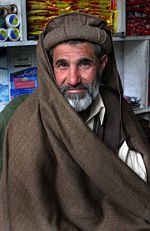
Pashtun culture was formed over the course of many centuries. Pre-Islamic traditions, probably dating back to as far as Alexander's conquest in 330 BC, survived in the form of traditional dances, while literary styles and music largely reflect strong influence from the Persian tradition and regional musical instruments fused with localized variants and interpretation. Pashtun culture is a unique blend of native customs and strong influences from Central, South and West Asia.
Language
The Pashtuns speak Pashto, an Indo-European language. It belongs to the Iranian sub-group of the Indo-Iranian branch. It can be further delineated within Eastern Iranian and Southeastern Iranian. Pashto is written in the Perso-Arabic script and is divided into two main dialects, the northern "Pukhtu" and the southern "Pashto".
Pashto has ancient origins and bears similarities to extinct languages such as Avestan and Bactrian. Its closest modern relatives include Pamir languages, such as Shughni and Wakhi, and Ossetic. Pashto has an ancient legacy of borrowing vocabulary from neighboring languages including Persian and Vedic Sanskrit. Invaders have left vestiges as well as Pashto has borrowed words from Ancient Greek, Arabic and Turkic, sometimes due to invasions. Modern borrowings come primarily from English.
Fluency in Pashto is often the main determinant of group acceptance as to who is considered a Pashtun. Pashtun nationalism emerged following the rise of Pashto poetry that linked language and ethnic identity. This started with the work of Khushal Khan Khattak and continued with his grandson Afzal Khan (author of Tarikh-e Morassa, a history of the Pashtun people).
Pashto has national status in Afghanistan and regional status in Pakistan. In addition to their mother-tongue, many Pashtuns are fluent in Dari (Afghan Persian), Urdu and English.
Religion
Most Pashtuns follow Sunni Islam, almost completely the Hanafi school. A minority of Twelver Shi'a Pashtuns exist in Afghanistan and Pakistan.
Studies conducted among the Ghilzai reveal strong links between tribal affiliation and membership in the larger ummah (Islamic community). Most Pashtuns believe that they are descendants of Qais Abdur Rashid who is purported to have been an early convert to Islam and thus bequeathed the faith to the Pashtun population. A legacy of Sufi activity remains common in Pashtun regions, as evident in song and dance. Many Pashtuns are prominent Ulema, Islamic scholars, such as Dr. Muhammad Muhsin Khan who translated the Noble Quran and Sahih Al-Bukhari and many other books to English. Lastly, non-Muslim Pashtuns are virtually non-existent as there is limited data regarding irreligious groups and minorities.
Pashtunwali
The term "Pakhto" or "Pashto" from which the Pashtuns derive their name is not merely the name of their language, but is synonymous with a pre-Islamic honour code/religion formally known as Pashtunwali (or Pakhtunwali). Pashtunwali is believed to have originated millennia ago during pagan times and has, in many ways, fused with Islamic tradition. Pashtunwali governs and regulates nearly all aspects of Pashtun life ranging from tribal affairs to individual "honour" (nang) and behaviour.
Numerous intricate tenets of Pashtunwali influence Pashtun social behaviour. One of the better known tenets is Melmastia, hospitality and asylum to all guests seeking help. Perceived injustice calls for Badal, swift revenge. A popular Pashtun saying, "Revenge is a dish best served cold", was borrowed by the British and popularized in the West. Men are expected to protect Zan, Zar, Zameen, which translates to women, treasure, and land. Some aspects promote peaceful co-existence, such as Nanawati, the humble admission of guilt for a wrong committed, which should result in automatic forgiveness from the wronged party. These and other basic precepts of Pashtunwali continue to be followed by many Pashtuns, especially in rural areas.
Sports
Traditional sports include naiza bazi, which involves horsemen who compete in spear throwing.
Polo is also an ancient traditional sport in the region and is a popular among many tribesmen such as the Yousafzai. Like other Afghans, many Pashtuns engage in wrestling ( Pehlwani), which is often part of larger sporting events. Cricket is largely a legacy of British rule in Pakistan, and many Pashtuns have become prominent participants, such as Shahid Afridi and Imran Khan.
Football is a more recent sport that increasing numbers of Pashtuns have started to play. Children engage in various games including a form of marbles called buzul-bazi which is played with the knuckle bones of sheep. Although traditionally less involved in sports than boys, young Pashtun girls often play volleyball and basketball, especially in urban areas.
The favourite game of Pushtoon in South-Western Pakistan - Pishin is yanda. Cricket is also one of the Favourite games played in Khudaidadzai - Pishin. Mohammad Nawaz Khan Tareen was the first person who established cricked in Khudaidadzai.
The more recent sport of Pishin is Hunting. There is a beautiful lake called Band Khushdil Khan near Killi Torashah. The people of these villages playing hunting in that lake. The duck hunting is so popular in band khushdil khan. The best hunters of the Pishin are Malak Mohammad Ali, Khan Asad Khan Tareen, Malak Qurban Ali, Inayat Ullah Khan, Asmat Ullah Khan, Sana Mamo, Master Bore Mohammad Saab, Jaan etc...
Performing arts
Pashtun performers remain avid participants in various physical forms of expression including dance, sword fighting, and other physical feats. Perhaps the most common form of artistic expression can be seen in the various forms of Pashtun dances.
One of the most prominent dances is Attan, which has ancient pagan roots. It was later modified by Islamic mysticism in some regions and has become the national dance of Afghanistan and various districts in Pakistan. A rigorous exercise, Attan is performed as musicians play various native instruments including the dhol (drums), tablas (percussions), rubab (a bowed string instrument), and toola (wooden flute). With a rapid circular motion, dancers perform until no one is left dancing, similar to Sufi whirling dervishes. Numerous other dances are affiliated with various tribes notably from Pakistan including the Khattak Wal Atanrh (eponymously named after the Khattak tribe), Mahsood Wal Atanrh (which, in modern times, involves the juggling of loaded rifles), and Waziro Atanrh among others. A sub-type of the Khattak Wal Atanrh known as the Braghoni involves the use of up to three swords and requires great skill. Though most dances are dominated by males, some performances such as Spin Takray feature female dancers. Young women and girls often entertain at weddings with the Tumbal (tambourine).
Traditional Pashtun music has ties to Klasik (traditional Afghan music heavily inspired by Hindustani classical music), Iranian musical traditions, and other various forms found in South Asia. Popular forms include the ghazal (sung poetry) and Sufi qawwali music. Themes revolve around love and religious introspection. Modern Pashto music is centered around the city of Peshawar due to the wars in Afghanistan, and tends to combine indigenous techniques and instruments with Iranian-inspired Persian music and Indian Filmi music prominent in Bollywood. Some well known Pashto singers include Nashenas, Sardar Ali Takkar, Naghma, Rahim Shah, Farhad Darya, Nazia Iqbal, and many others.
Other modern Pashtun media include an established Pashto-language film and television industry that is based in Pakistan. Producers based in Lahore have created Pashto-language films since the 1970s. Pashto films were once popular, but have declined both commercially and critically in recent years. Past films such as Yusuf Khan Sherbano dealt with serious subject matter, traditional stories, and legends, but since the 1980s the Pashto film industry has been accused of churning out increasingly lewd exploitation-style films. Pashtun lifestyle and issues have been raised by Western and Pashtun expatriate film-makers in recent years. One such film is In This World by British film-maker Michael Winterbottom, which chronicles the struggles of two Afghan youths who leave their refugee camps in Pakistan and try to move to the United Kingdom in search of a better life. Another is the British mini-series Traffik, re-made as the American film Traffic, which featured a Pashtun man (played by Jamal Shah) struggling to survive in a world with few opportunities outside the drug trade. Ethnic conflict between Pashtuns and other Afghans such as Hazaras was examined in the best-selling novel The Kite Runner, which was made into a major motion picture that was banned in Afghanistan due to fears that it would incite violence. Numerous actors of Pashtun descent work in India's Bollywood film industry, including Kader Khan and Feroz Khan.
Tribes
A prominent institution of the Pashtun people is the intricate system of tribes. The Pashtuns remain a predominantly tribal people, but the world-wide trend of urbanization has begun to alter Pashtun society as cities such as Peshawar and Quetta have grown rapidly due to the influx of rural Pashtuns and Afghan refugees. Despit this trend of urbanization, many people still identify themselves with various clans.
The tribal system has several levels of organization: the tribe, tabar, is divided into kinship groups called khels, in turn divided into smaller groups ( pllarina or plarganey), each consisting of several extended families called kahols. "A large tribe often has dozens of sub-tribes whose members may see themselves as belonging to each, some, or all of the sub-tribes in different social situations (co-operative, competitive, confrontational) and identify with each accordingly." Pashtun tribes are divided into four 'greater' tribal groups: Sarbans, Batians, Ghurghusht and Karlans.
Another prominent Pashtun institution is the Jirga or 'Senate' of elected elder men. Most decisions in tribal life are made by members of the Jirga, which is the main institution of authority that the largely egalitarian Pashtuns willingly acknowledge as a viable governing body.
Pashtun celebrations and special events are also often national holidays in Pakistan and Afghanistan. A common Turko-Iranian New Year called Nouruz is often observed by Pashtuns. Most prominent are Muslim holidays including Ramadan and Eid al-Fitr. Muslim holidays tend to be the most widely observed and commercial activity can come to a halt as large extended families gather in what is often both a religious duty and a festive celebration.
Women
The lives of Pashtun women vary from those who reside in conservative rural areas, such as the tribal belt, to those found in relatively freer urban centers. Though many Pashtun women remain tribal and illiterate, others have become educated and gainfully employed. The ravages of the Soviet occupation of Afghanistan and the Afghan wars, leading to the rise and fall of the Taliban, caused considerable hardship among Pashtun women, as many of their rights were curtailed in favour of a rigid interpretation of Islamic law. The difficult lives of Afghan female refugees gained considerable notoriety with the iconic image of the so-called "Afghan Girl" ( Sharbat Gula) depicted on the June 1985 cover of National Geographic magazine. The male-dominated code of Pashtunwali often constrains women and forces them into designated traditional roles that separate the genders. The pace of change and reform for women has been slow due to the wars in Afghanistan and the isolation and instability of tribal life in Pakistan.
Modern social reform for Pashtun women began in the 20th century. During the early 20th century, Queen Soraya Tarzi of Afghanistan was an early feminist leader whose advocacy of social reforms for women was so radical that it led to the fall of her and her husband King Amanullah's dynasty. Abandoning the Wardrobe and Reclaiming Religion in the Discourse on Afghan Women's Islamic Rights], Leela Jacinto, Civil rights remained an important issue during the tumultuous Soviet occupation of Afghanistan, as feminist leader Meena Keshwar Kamal campaigned for women's rights and founded the Revolutionary Women of Afghanistan (RAWA) in the 1980s.
Today, Pashtun women vary from the traditional housewives who live in seclusion to urban workers, some of whom seek or have attained parity with men. But due to numerous social hurdles, the literacy rate remains considerably lower for Pashtun females than for males. Abuse against women is widespread and increasingly being challenged by women's rights organizations which find themselves struggling with conservative religious groups as well as government officials in both Pakistan and Afghanistan. According to researcher Benedicte Grima's book Performance of Emotion Among Paxtun Women, "a powerful ethic of forbearance severely limits the ability of traditional Pashtun women to mitigate the suffering they acknowledge in their lives."
Pashtun women often have their legal rights curtailed in favour of their husbands or male relatives. For example, though women are officially allowed to vote in Afghanistan and Pakistan, many have been kept away from ballot boxes by males. Traditionally, Pashtun women have few inheritance rights and are often charged with taking care of large extended families of their spouses. Another tradition that persists is swara, the giving of a female relative to someone in order to rectify a dispute. It was declared illegal in Pakistan in 2000 but continues in tribal regions.
Despite obstacles, many Pashtun women have begun a process of slow change. A rich oral tradition and resurgence of poetry has inspired many Pashtun women seeking to learn to read and write. Further challenging the status quo, Vida Samadzai was selected as Miss Afghanistan in 2003, a feat that was received with a mixture of support from those who back the individual rights of women and those who view such displays as anti-traditionalist and un-Islamic. Many Pashtun women have attained high political office in Pakistan. In Afghanistan, following recent elections, the proportion of female political representatives is one of the highest in the world. Pashtun women are now TV hosts, journalists, actors and singers on AVT Khyber and other Pashto TV outlets. A Pashtun woman, Khatol Mohammadzai, recently became a paratrooper in the Afghan National Army and another became a fighter pilot in the Pakistan Air Force.
Substantial work remains for Pashtun women to gain equal rights with men, who remain disproportionately dominant in most aspects of Pashtun society. Human rights organizations continue to struggle for greater women's rights, such as the Afghan Women's Network and the Aurat Foundation in Pakistan which aims to protect women from domestic violence. Due to recent reforms in the higher education commission (HEC) of Pakistan, a number of competent Pashtun female scholars have been able to win Masters and PhD scholarships. Most of them have proceeded to USA, UK and other developed countries with support from their families.
